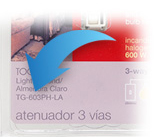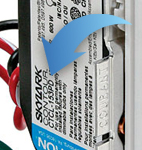
Explore Knowledge Articles
HomeWorks QSX Integration with CoolMaster LP by CoolAutomation
Variable Refrigerant Volume (VRV) or Variable Refrigerant Flow (VRF) systems are commonly used for Heating, Ventilation, and Air Conditioning (HVAC). With the implementation of an interface, the HomeWorks system can easily integrate with various VRV/VRF brands. The CoolMaster LP by CoolAutomation allows for the control of VRV / VRF HVAC systems and uses Lutron’s Extensible Application Protocol (LEAP) API for direct integration with HomeWorks.
Table of Contents
- Connecting the CoolMaster LP to the HomeWorks System
- Implementing CoolMaster LP into a HomeWorks Database
- Additional Resources
Connecting the CoolMaster LP to the HomeWorks System
The CoolMaster LP by CoolAutomation allows for the control of VRV / VRF HVAC systems from third-party and mobile applications. This interface connects directly to the local area network (LAN) within the residence allowing for direct integration with the HomeWorks system using Lutron’s Extensible Application Protocol (LEAP) API.
The CoolMaster LP interface(s) must all be connected to the same LAN that the HomeWorks processor(s) reside(s) on.
Implementing CoolMaster LP into a HomeWorks Database
Adding the CoolMaster LP to a HomeWorks project Database is like adding any other 3rd party HVAC interface to the software Design and Programming. However, since it acts as a client device and uses Lutron’s API, the device does not require ethernet link assignment in the software. Additionally, with this LEAP interface CoolAutomation can receive the temperature settings from the Lutron Palladiom thermostat. For this functionality, the Lutron Palladiom thermostat must also be added to the design, and the CoolMaster LP must be properly assigned to it.
Database Design for CoolMaster LP
STEP 1 | Configure the CoolMaster LP HVAC Controller in Design > Equipment
- Add the 3rd Party HVAC controller to an area.
- Change the Manufacturer to “Cool Automation”
- Change the Model to “CoolMaster LP”
- Define the attributes for the HVAC Zone (Zone Name, Areas, Operating Modes, Fan Speeds)
NOTE: If tied to a Palladiom Thermostat the CoolMaster LP interface does not support Fan-only or Dry operating modes. With software v.25.7 the CoolMaster LP does support Auto mode when tied to a Palladiom Thermostat.
NOTE: Under “Areas” only select the area where the Palladiom thermostat is located to provide the best user experience in the Lutron App.
- Assign additional HVAC Zones as needed. One CoolMaster LP can control multiple zones (maximum quantity depends on the manufacturer of the HVAC system).
NOTE: Additional HVAC Zones can be created by clicking “Assign…” then “New Zone” or by navigating to Design > Loads > HVAC Zones tab. Remember to define the attributes for the additional HVAC Zones (Zone Name, Areas, Operating Modes, Fan Speeds) as well.
When using a Palladiom thermostat steps 2 & 3 are REQUIRED.
STEP 2 | OPTIONAL: If you are using Palladiom thermostat(s) assign the HVAC zones to Palladiom thermostats in Design > Controls
- Add the Palladiom thermostat(s) to the area(s) on the project.
- Assign the CoolMaster LP HVAC Zone(s) to the Palladiom thermostat(s) using the Remote Zone tab.
STEP 3 | OPTIONAL: If you are using Palladiom thermostat(s) assign the thermostat(s) to the HomeWorks system QS Link in Design > Link Assignment
NOTE: Assigning the CoolMaster LP HVAC controller to the Ethernet link in the link assignment is not required. Ethernet link assignment is only required when the Lutron system acts as a client and needs to maintain a connection to a 3rd party server. A CoolMaster LP uses Lutron’s API and is the client device, maintaining a connection to a Lutron processor in the system.
Database Programming for CoolMaster LP
Thermostat schedules can be programmed to define specific setpoints for the CoolMaster LP HVAC zone(s). Additionally, the temperature setpoints for each CoolMaster LP HVAC zone can be adjusted from Keypad buttons, CCIs, Occupancy/Vacancy Sensors, and Timeclock Events. Follow standard practices to program the HVAC zones controlled by the CoolMaster LP controller.
Programming Schedules for HVAC Zones
STEP 1 | Navigate to Program > Thermostat to program the HVAC schedules.
- Select the correct HVAC Zone.
- Define the desired setpoints at each time of day for up to seven schedules per HVAC zone.
NOTE: If similar schedules are desired for multiple zones of HVAC schedules can be copied from one zone to another by right clicking on the HVAC Zone.
Changing HVAC Setpoints and Modes from Keypad buttons, CCIs, Occupancy/Vacancy Sensors, or Timeclock Events
STEP 1 | Navigate to the appropriate programmable device and/or button and select “HVAC Zones” under the assignable items dropdown to define the desired settings.
- Select the “Target” checkbox and type the desired temperature setpoint.
NOTE: If “Heat” and/or “Cool” is not selected as an operating mode for the HVAC Controller in Design > Equipment target setpoints cannot be selected. Review the Database Design for CoolMaster LP section of this article.
- Select “Run” for Schedules.
- Select either “Heat” or “Cool” for the Operating Mode. If left as “Unaffected” or “Off” the system will not go to the desired setpoint.
- Select any Fan Speed.
Temperature Setpoint NOTE: If a target temperature setpoint is defined and “Run” is not selected for schedules, the HVAC setpoint will not adjust automatically at the scheduled time that’s defined by the programming in Program > Thermostats, until another manual trigger is added to run the schedules. Setpoints can still be adjusted from the Palladiom Thermostat while schedules are not running. It is recommended to always select “Run” for schedules when defining setpoints from buttons, CCI’s, Occupancy/Vacancy Sensors, or Timeclocks.
Hold Schedules NOTE: If schedules are placed on “Hold” the HVAC setpoint will not adjust automatically at the scheduled time that’s defined by the programming in Program > Thermostats, until another manual trigger is added to run the schedules. Setpoints can still be adjusted from the Palladiom Thermostat while schedules are on hold. It is recommended to always add a trigger to “Run” Schedules if there is a trigger to “Hold” Schedules, so that the schedules can be resumed by the user.
Additional Resources
- For additional information about Lutron’s Extensible Application Protocol view the Knowledge article for Lutrons LEAP API Integration Protocol.
- For additional information, including HVAC system compatibility and device settings, please refer to the documentation provided by CoolAutomation, available at www.coolautomation.com
- View Lutron’s Application Note #650 for details about other CoolAutomation interface applications. The application notes details:
- How to interface CoolMasterNet, CooLinkNet, and CoolMaster by CoolAutomation, with a HomeWorks system for the control of VRV / VRF HVAC systems
- How to interface CoolPlug with the HomeWorks and myRoom Palladiom thermostats for the control of compatible VRV / VRF HVAC systems.


